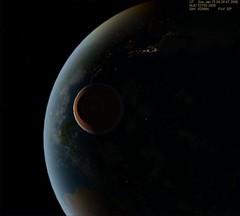
NASA's Stardust Comet Sample Return Mission is on track to land (mission timeline here) in Utah early Sunday morning. Thanks to add-on maker Brian Jones, it's possible to simulate the Stardust mission in Orbiter (the add-on has been available for a while on avsim.com). Another Orbiter user (Donald Tinc) has helpfully posted updated orbital elements the last few days as the spacecraft has approached Earth. By text-editing Brian's return scenario file (he also provides a launch scenario and a simulated comet to visit, but I didn't try those parts of the mission myself), I introduced the updated elements from earlier today and simulated Stardust's reentry and landing. Brian also provides a tip in that forum post for an adjustment to a drag factor in the capsule's initialization file. This helps the accuracy of the reentry (without this, my first attempt seemed to skip off the Earth's atmosphere).
If you start with the "close-in" orbital elements, all the course corrections have been incorporated, and the only real control you have is when to separate the return capsule from the "bus" (I followed NASA's timeline) and when to deploy the drogue and main chutes (the separated capsule has no maneuvering thrusters). You can also try (as NASA will do successfully, I'm sure) to maneuver the bus spacecraft after separation to get it to miss the Earth and enter a solar orbit. I need some work on this part, but my landing was pretty good -- at least it was in Utah, about 190 km southwest of Salt Lake City, near the Nevada border (map and other graphics on Flickr). Now I'll really be interested to see where the real spacecraft lands (Update on January 15: it landed safely in the Dugway Proving Grounds near Michael Army Air Field, about 90 km northeast of my simulated landing).
Note that although I did not try it myself, Orbiter is accurate enough to recreate the entire seven-year mission from launch, including three orbits of the Sun and a gravitational "slingshot" around Earth to set up the comet encounter. I just did the easy stuff tonight!
P.S. For an excellent summary of scientific aspects of the Stardust mission, see this new post by Anthony Kendall. This New Scientist graphic is a great visual summary of the successful mission.
No comments:
Post a Comment